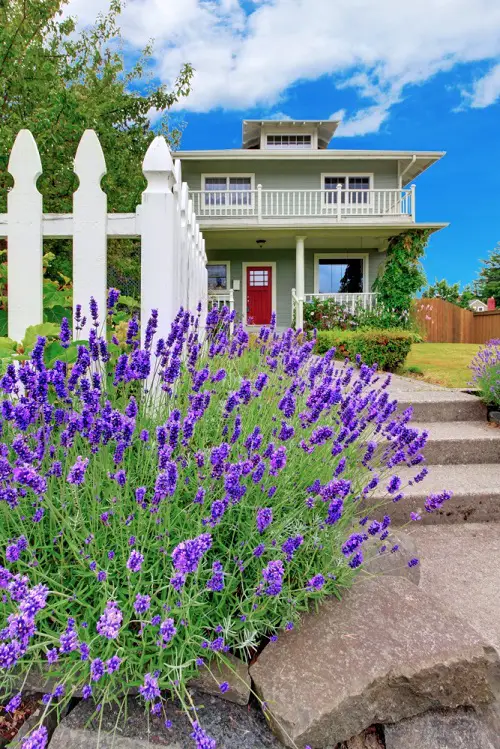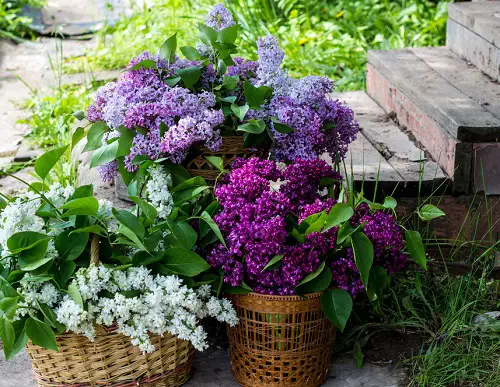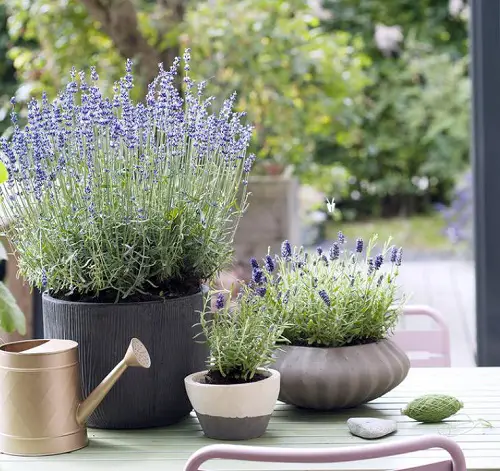Lavender vs Lilac – This has always sparked a lot of interest in people and this article will cover all the details!
Lavender and lilac are two popular flowering plants that are often compared for their beauty, fragrance and uses. While they share some similarities, there are also several key differences between them that make each unique. Let’s have a look at Lavender vs Lilac!
Lavender Flower

- Lavender, a member of the mint family Lamiaceae, is a small plant with fragrant soft needle-like leaves.
- Its flowers, produced in whorls on spikes rising above the foliage, range in color from deep bluish-purple to soft purple-grey hues.
- In addition to its culinary uses, lavender is widely used in herbal teas and condiments.
- With its distinctive light, fresh, floral scent, lavender is cultivated both as a garden ornamental and for its essential oils.
Lilac Flower

- Lilac, or Syringa vulgaris, is a hardy shrub that blooms with fragrant flowers during summer.
- It belongs to the Olive family, Oleaceae, and grows canes from the base.
- The flowers grow in clusters with a tubular base opening into a trumpet shape, and they range in color from light purple to pinkish mauve.
- The scent of lilac is richly floral, similar to rose, with hints of vanilla.
- Lilac is utilized in herbal medicine and aromatherapy, and its beautiful flowers make it a popular ornamental shrub in gardens.
Learn How to Grow Lavender Plants here
Lavender vs Lilac
Both lilac and lavender are beloved for their fragrant flowers and beautiful appearance in gardens, but there are several key differences that set them apart. Here’s a comprehensive look at how lilac differs from lavender, with the differences divided into major and minor categories.
1. Botanical Family
- Lilac: Belongs to the Oleaceae family, specifically the genus Syringa.
- Lavender: Part of the Lamiaceae family, within the genus Lavandula.
2. Plant Type
- Lilac: Mainly shrubs or small trees, often reaching 5-15 feet in height.
- Lavender: Typically a small shrub or herbaceous perennial, growing 1-3 feet tall.
3. Flower Color and Appearance
- Lilac: Blooms are usually purple or white and grow in dense clusters.
- Lavender: Flowers are typically various shades of purple, arranged in spikes.
4. Fragrance
- Lilac: Sweet and strong fragrance.
- Lavender: Herbaceous and soothing aroma often used in aromatherapy.
5. Growing Zones
- Lilac: Thrives in USDA zones 3-7.
- Lavender: Prefers USDA zones 5-9.
6. Uses
- Lilac: Primarily ornamental, used for landscaping.
- Lavender: Used for culinary, medicinal, and cosmetic purposes, besides ornamental uses.
7. Bloom Time
- Lilac: Blooms in late spring.
- Lavender: Flowers in late spring to summer, depending on the variety.
8. Soil Requirements
- Lilac: Prefers slightly alkaline soil.
- Lavender: Requires well-drained soil with neutral to slightly alkaline pH.
9. Care and Maintenance
- Lilac: Needs regular pruning to maintain shape.
- Lavender: Requires frequent trimming to promote bushy growth and more blooms.
10. Pest and Disease Resistance
- Lilac: Can be susceptible to powdery mildew.
- Lavender: Generally more resistant to common pests and diseases.
Read Guide to Grow Lavender in Tropics here
Lavender vs Lilac Color
1. Hue
- Lavender: A pale violet shade mixed with blue, giving it a slightly cooler appearance.
- Lilac: A pale violet shade mixed with pink, making it a warmer hue.
2. Color Family
- Lavender: Belongs to the blue-purple part of the color spectrum.
- Lilac: Associated with the pink-purple range of colors.
3. Associations and Symbolism
- Lavender: Often symbolizes elegance, grace, and calmness.
- Lilac: Commonly associated with first love, innocence, and youthfulness.
Learn How to Grow Miss Kim Lilac here
FAQs
1. Can I Use Both Lavender and Lilac Flowers in Cooking and Teas?
Yes, lavender is commonly used in culinary applications, such as flavoring desserts and making herbal teas. Lilac flowers are not typically used in cooking due to their milder scent and potential bitterness.
2. Are Lavender and Lilac Suitable for Container Gardening?
Lavender can thrive in containers if provided with proper drainage and sunlight. Lilacs, being larger shrubs, are less suitable for containers and are usually planted directly in the ground.
3. Do Lavender and Lilac Attract Pollinators to Gardens?
Both lavender and lilac flowers are known to attract pollinators like bees and butterflies, making them beneficial for garden biodiversity.
4. Can I Grow Lavender and Lilac in the Same Garden?
While lavender and lilac have different growing requirements, it’s possible to plant them in the same garden. However, ensure they have adequate space, sunlight, and soil conditions suited to their individual needs.



